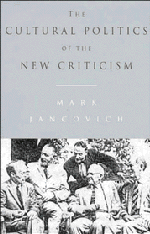Book contents
- Frontmatter
- Contents
- Preface
- List of abbreviations
- Part I The New Criticism and its critics
- 1 Contemporary responses to the New Criticism
- 2 The historical context of the New Criticism
- 3 Before the New Criticism
- Conclusion
- Part II The formation of the New Criticism
- Part III The establishment of the New Criticism
- Part IV The development of the New Criticism
- Conclusion: Modernism and postmodernism within the American academy
- Conclusion
- Notes
- Bibliography
- Index
1 - Contemporary responses to the New Criticism
Published online by Cambridge University Press: 18 December 2009
- Frontmatter
- Contents
- Preface
- List of abbreviations
- Part I The New Criticism and its critics
- 1 Contemporary responses to the New Criticism
- 2 The historical context of the New Criticism
- 3 Before the New Criticism
- Conclusion
- Part II The formation of the New Criticism
- Part III The establishment of the New Criticism
- Part IV The development of the New Criticism
- Conclusion: Modernism and postmodernism within the American academy
- Conclusion
- Notes
- Bibliography
- Index
Summary
In his book, After the New Criticism, Frank Lentricchia attempts to counter ‘two misleading perspectives’ which may be suggested by his book's title. He argues that the New Criticism was never a monolithic entity; and that the period defined by the title is not one distinguished by the absence of the New Criticism, but, in a very important sense, one which is distinguished by its presence. In the case of the first argument, he describes the New Criticism as ‘an inconsistent and sometimes confused movement’. Unfortunately, while he does acknowledge real differences within the movement, he regards these as the result of weakness or a lack of clarity, rather than the disagreements and discussions which are present in any critical discourse. Lentricchia fails to acknowledge that the social organization of the New Criticism was very different from that of contemporary criticism – at least in its early stages. While the New Critics did share a common reaction against previous forms of criticism, and while they relied on similar intellectual traditions, their social organization was largely that of an informal group which only began to formalize itself in an attempt to reorganize the teaching of English in America. Contemporary criticism, on the other hand, is defined within specific institutional and theoretical structures which tend to make it far more monolithic.
This situation is also related to Lentricchia's second argument.
- Type
- Chapter
- Information
- The Cultural Politics of the New Criticism , pp. 3 - 10Publisher: Cambridge University PressPrint publication year: 1993



